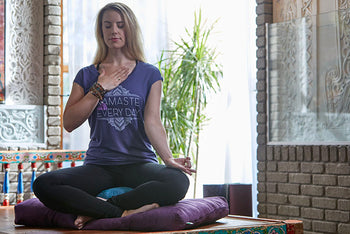What is Yoga Nidra?

by: Carlye Cole
Experience Yoga Nidra – Try 7 Days Free from the top rated yoga app Yoga Studio App.
We all have those days. Busy, chaotic, anxiety-inducing days that leave us craving peace and stillness. So often we hear about turning to something like meditation to help relieve our stress and quiet our minds, but sometimes meditation isn’t always the right choice. If it’s the end of the day and I feel utterly exhausted in a sitting position, I will probably fall asleep. Trying to force my spine into an upright position becomes very distracting, so on these types of days I instead opt for a yoga nidra practice. Because this practice is guided, I can focus on the teacher’s words without falling asleep and still feel the benefits of a calm and quiet mind.
When we’ve worked ourselves into states of depletion, we should then turn our focus on restoration. Students so often seem to come to yoga class in order to exert themselves, wake up, or push through an unresolved issue or ailment. Yoga nidra allows us to work with blockages or ailments within the body rather than push past them. We do this by generously restoring ourselves with deep relaxation and inward attention.
So what is yoga nidra exactly? It’s a systematic relaxation technique that guides the practitioner into conscious deep relaxation. It’s designed to cultivate inner awareness and relaxes the physical, emotional, and mental systems. It has been called “psychic sleep,” although there remains complete awareness and focus of attention to individual body parts and states of consciousness.
The practitioner lies down savasana-style, consciously perceiving their own body and mind with guidance and support from the teacher. In Patanjali’s Yoga Sutras, yoga nidra can be likened to the fifth limb: Pratyahara (withdrawal of the senses) which heightens inner awareness and concentration. Since many acute and chronic diseases (like migraines and insomnia) are enhanced by stress upon the nervous system, yoga nidra is a tool that can aid in the reduction of many symptoms simply by inducing relaxation throughout the whole nervous system. When practiced on a regular basis, some benefits may include:
- Stress, tension, and anxiety reduction
- Increased stress resistance
- Improved memory
- Pain relief
A particular yoga nidra practice of mine stands out in my mind. I laid on the concrete floor with a thin layer of carpet and yoga mat beneath me knowing there was no way I was going to comfortably drift off to sleep. I was just uncomfortable enough to remain awake and keep my attention on the guided words. My mind became quiet except for the sound of my teacher’s voice far off in the distance guiding the practice. Upon completion, my body felt heavier, as if I’d gained something, but my mind was completely calm, clear, and light. After getting my blood moving again, I was spellbound by the change my mind and body had undergone.
I am excited to share more yoga nidra through my new guided videos on the Yoga Studio app. Try doing it just before bed and notice how much deeper and sounder your sleep will be :)
Carlye is a 500 hour E-RYT specialising in hatha, vinyasa, and yin yoga and meditation. After studying hatha yoga in Michigan and teaching in Taiwan, she went to Rishikesh, the birthplace of yoga, to further her training and study before moving on to teach diverse and unique classes in Costa Rica, Michigan, and Colorado. Her work focuses on bringing students a holistic understanding of yoga while creating peaceful and positive experiences through her classes, workshops, retreats, and recorded meditations. Insta: @yogawithcarlye
Also in Blog

Body Peace & Personal Empowerment

Yoga for Swimmers: Poses for Strength and Mobility







